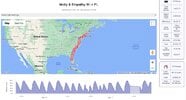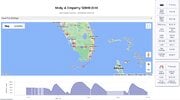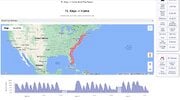Hey Everyone,
I thought I would share my experience with my most significant towing trip yet. I have a '20 MYP "stealth," which was originally rated at 315 mi of range. Now my 100% range is about 298.
Something I've wanted to do for a long time is bring my boat, a small trimaran, to the FL Keys, and WFB (work from boat). The boat & Trailer weigh 3200 lbs, and compared to the car, the boat is quite large from an aerodynamic cross-section point of view.
I used to have an '08 Subaru Outbakc XT, and it wasn't a great tow vehicle. Mostly b/c it was a manual, but also its suspension wasn't durable enough for towing my boat, even though I was within the towing capacity. When I bought the MY, it was with the explicit intent to be able to tow my boat, including long distances.
Rather that over-analyze the whole trip, I'll just share my top take-aways and final charging/driving strategy, and we'll see what questions people ask. I'll also share summaries of the trips with charge-stop maps. There were three legs, RI-> Sarasota, Sarasota-> Bahia Hoda Key, and BHK -> RI.

I thought I would share my experience with my most significant towing trip yet. I have a '20 MYP "stealth," which was originally rated at 315 mi of range. Now my 100% range is about 298.
Something I've wanted to do for a long time is bring my boat, a small trimaran, to the FL Keys, and WFB (work from boat). The boat & Trailer weigh 3200 lbs, and compared to the car, the boat is quite large from an aerodynamic cross-section point of view.
I used to have an '08 Subaru Outbakc XT, and it wasn't a great tow vehicle. Mostly b/c it was a manual, but also its suspension wasn't durable enough for towing my boat, even though I was within the towing capacity. When I bought the MY, it was with the explicit intent to be able to tow my boat, including long distances.
Rather that over-analyze the whole trip, I'll just share my top take-aways and final charging/driving strategy, and we'll see what questions people ask. I'll also share summaries of the trips with charge-stop maps. There were three legs, RI-> Sarasota, Sarasota-> Bahia Hoda Key, and BHK -> RI.
- On the way down, I was originally trying to maximize leg length. I dropped that plan quickly. I could have done 100mi legs every time, but it would require charing to 100% which is really slow, and it also required driving 52mph or less - while driving with a big boat makes going slow a good idea anyway, driving this slow adds to faigue simply b/c it takes longer to get to the next stop.
- 75-85 mile legs seemed like a good balance - I appreciated the rest every 70 minutes or so.
- 27 charges on the way there, 25 on the way home
- Weirdly, on the way home i was able to maintain 60-64 mph on most legs, it came down to 58 in the northeast
- I think the warmer temps & smoother better maintained highways in the south helped a lot with range
- However, I also noticed that giving myself about an 8% buffer meant I could try out different speeds (every leg was different), while still having enough reserve to not stress if driving ended up being less efficient on that particular leg.
- I also think that driving with a buffer of 6-8% of charge lets you make overall higher average speeds: I was able to test out higher speeds at first, but watch the SOC and remaining distance diverge, and slow down until they were matching each other. Without at least 5% buffer, I would have to drive 51 mph instead of 60, b/c it really is an emergency to build your buffer back up if you end up even a little in the hole in terms of making it to your next charger.
- Ultimately I chose charging stops based on #1 if they were on the highway, and #2 if they had a lot of stalls (16+). That pairing is worth having a leg be short by 20 miles b/c it's so easy when you don't have to go off into some town to charge, and when there are 16 stalls, there are usually 4 in a row free that I can pull in front of sideways, to charge w/out disconnecting, and with enough other free stalls that I wasn't blocking anybody.
- When I had to drive 51 before, that was because I had no margin for error on my charge; if I was projected to be even at 0% at the next charger, then I had to slow way down to build up a buffer asap
- The car's power and power delivery are so good tha I repeatedly forgot I was towing a 3200 lb boat & trailer, and had to look in the mirrors to make sure I still was.
- As before regenerative braking works perfectly while towing near the limit - I was nearly always able to stop single pedal.





